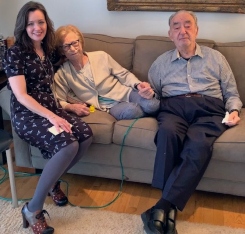Your Patient Can Be Home With Hospice Care
When traditional treatments or cures are no longer effective and care goals are focused more on comfort, VITAS Healthcare offers hospice care for your patients in the care setting of their choice.
For many patients, this means remaining at home, surrounded by loved ones.
If a patient is hospice-eligible, a team of clinical experts visits them in their home or other care setting to provide coordinated care. Hospice physicians and team members work with the patient’s primary care doctor or specialist to meet clinical and emotional needs and carry out the care plan appropriately.
Referring physicians can choose how involved they want to be in their patient’s care.
Benefits of Hospice Care—for You and Your Patient
Hospice care is unique because it puts the patient and family at the center of the care plan—a care plan that’s based upon their wishes, values and goals. For many patients, these goals are about quality of life near the end of life: being comfortable, at home, with help to manage their pain and symptoms.
Hospice teams assist physicians with the challenges of end-of-life symptoms, including reducing ongoing ED visits and hospital readmissions. Your patient leverages the Medicare hospice benefit to receive compassionate care in a familiar place.
- Hospice Expertise and Support: A VITAS interdisciplinary team—doctor, nurse, hospice aide, social worker, chaplain, bereavement specialist, and volunteer—handles clinical, psychosocial, and spiritual care. Patient-centered care plans are updated regularly. The patient's primary care physician (PCP) can choose to stay involved.
- Complex Modalities and High-Acuity Care: For patients with acute symptoms, VITAS offers higher levels of care to stabilize their condition. This includes aggressive symptom management in any setting via traditional treatments along with parenteral interventions, high-flow O2, inotropic therapy, and more.
- Hospice-Related Equipment, Supplies, and Prescriptions: VITAS Home Medical Equipment delivers equipment and supplies (e.g., hospital bed, wheelchair, diapers, oxygen) to the patient’s home. VITAS also offers an open formulary, including continuation of disease-directed medications such as beta blockers, ace inhibitors, diuretics, inhalers, cholinesterase inhibitors (i.e., donepezil), etc., with VITAS nurse supervision.
- 24/7 Care Focused on Calm, Comfort, and Quality of Life
- Regular home visits by the hospice team support the patient and the family caregiver.
- Continuous care, when medically appropriate, provides temporary 24-hour continuous care shifts (VITAS calls this service Intensive Comfort Care®) to the bedside until symptoms resolve.
- Telecare provides 24/7 access to a patient care expert who can answer questions, solve crises, or dispatch an on-call hospice runner to the home. The goal is to avoid costly hospital re-admissions and unnecessary emergency department visits.
When home care isn’t enough, inpatient care is available to control symptoms and crises, or to provide family caregivers up to 5 days of respite care.
Making the Hospice Choice Sooner
Research consistently shows that hospice care results in improved patient and family satisfaction.1,2 Studies show that most patients with advanced illness would benefit from being referred to hospice sooner for comprehensive care.2,3
Helping qualified Medicare beneficiaries make an informed decision about the type of care they wish to receive near the end of life is critical. Talking about hospice, or using the word “hospice,” does not mean giving up. Usually, people with advanced illness and their physicians have decided that medical treatments are no longer effective or that side effects are no longer bearable.
Have you asked your seriously ill patients about their desires for advanced care? Perhaps it is time to have this conversation with your patients and offer them the choice of hospice services to enhance their quality of life.
1Kumar, P., et al. (2017). Family perspectives on hospice care experiences of patients with cancer. Journal of Clinical Oncology, 35(4), 432.
2Teno, J. et al. (2007). Timing of referral to hospice and quality of care: length of stay and bereaved family members’ perceptions of the timing of hospice referral. Journal of Pain and Symptom Management, 34(2), 120-125.
3Trella Health (2020). Quantifying Hospice’s End-of-Life Impact. Available at: https://www.trellahealth.com/portfolio_page/ quantifying-hospices-end-of-life-impact

